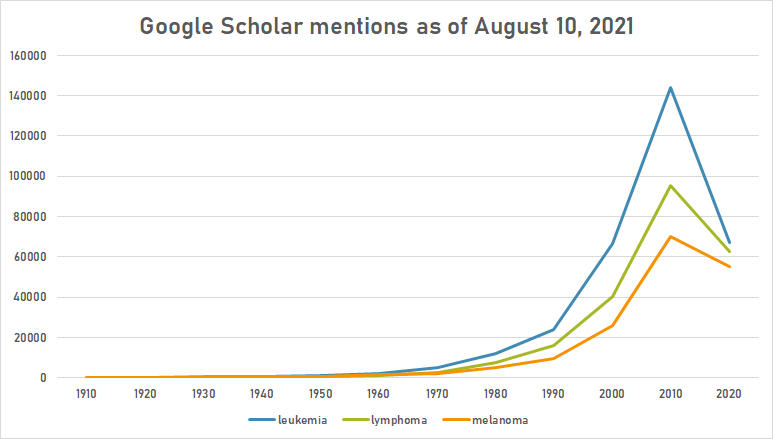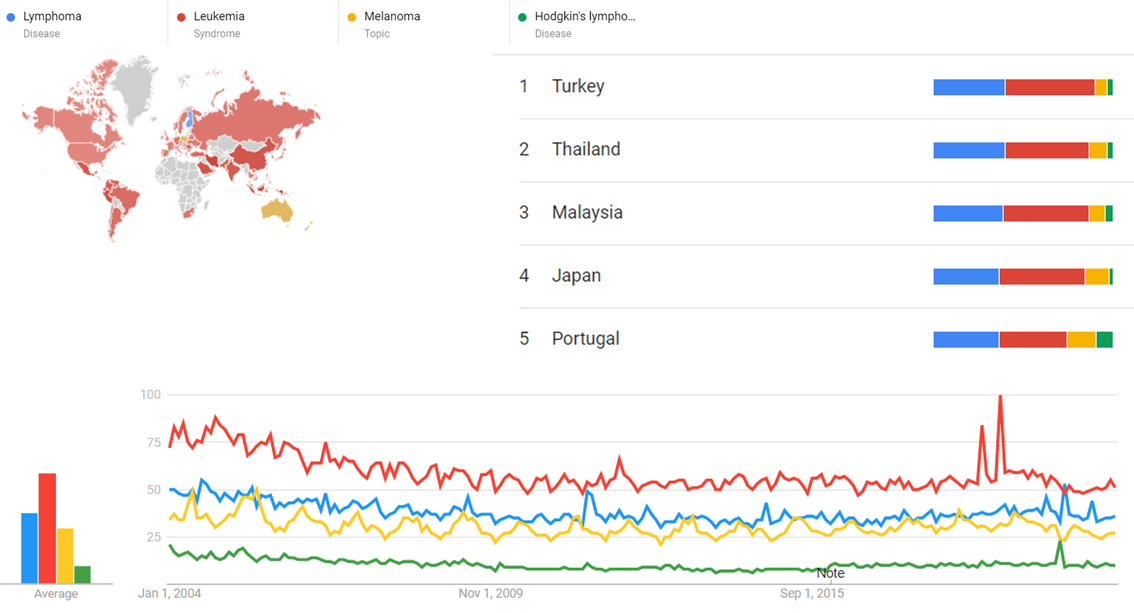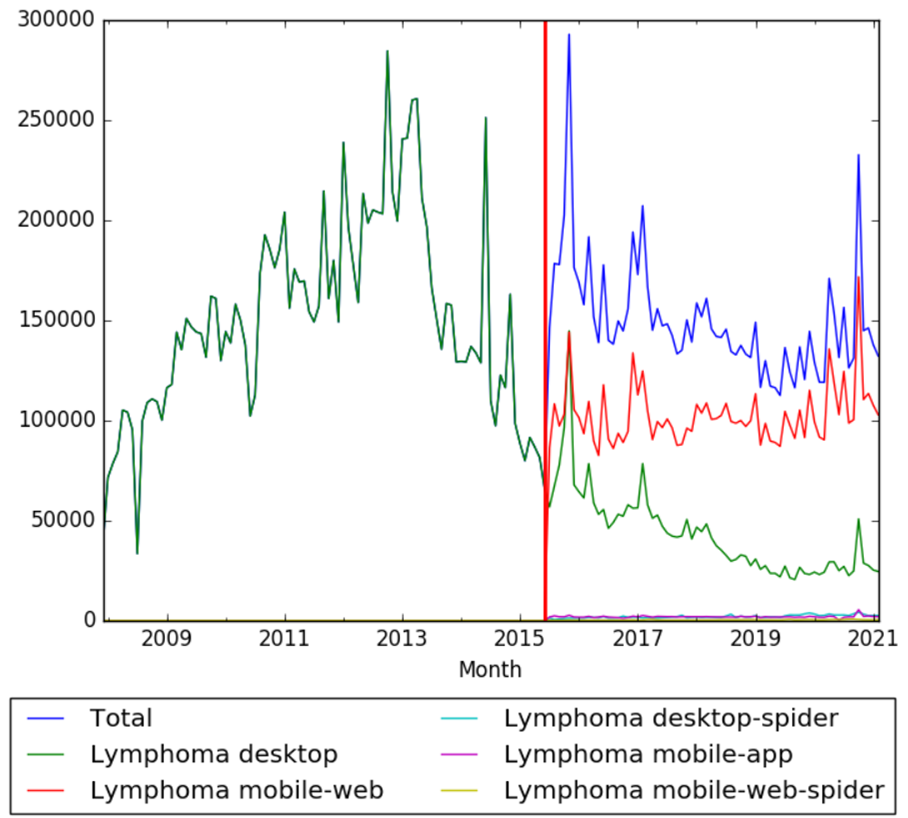Timeline of lymphoma
This is a timeline of lymphoma, describing especially major discoveries and advances in treatment against the disease.
Big picture
| Year/period | Key developments |
|---|---|
| 19th Century | The presence of lymphoma in western medical literature is born after the works of people like Thomas Hodgkin and Samuel Wilks. Hodgkin's lymphoma is the first lymphoma to be described. |
| 1900–1950s | It is found that radiation therapy can cure some patients with Hodgkin lymphoma, one of two major classes of lymphomas. When it is discovered that radiating larger parts of the body improves cure rates, physicians begin increasing the size of the radiation fields. Radiotherapy starts to prove successful as a treatment against Hodgkin's lymphoma in the 1940s.[1] However, long-term effects of radiation to the chest (including cardiovascular disease and second cancers) are later recognized, and efforts start to be taken to reduce radiation exposure to healthy tissue.[2] |
| 1960s–1970s | Very effective treatments for Hodgkin's lymphoma are developed in this period.[3] Chemotherapeutic agents are combined into regimens capable of eradicating and even disseminating the disease.[4] Combination of chemotherapy and high-energy radiation therapy are introduced.[5] |
| 1990s–present | Modern era of treatment for Hodgkin's lymphoma, focusing on reducing both toxicity and duration of chemotherapy.[4] Lymphomas developed in 566,000 people in 2012 and caused 305,000 deaths worldwide.[6] They comprise the seventh-most common form of cancers making up the 3–4% of them.[7] |
Full timeline
| Year/period | Type of event | Event | Location |
|---|---|---|---|
| 1666 | Development | Italian biologist Marcello Malpighi publishes De viscerum structuru exercitatio anatomica, where he describes what later will be known as Hodgkin's lymphoma.[8] | |
| 1832 | Development | British physician Thomas Hodgkin presents a paper describing seven patients with painless enlargement of the lymph nodes, and including autopsy findings and illustrations from one of the patients.[8] | London, United Kingdom |
| 1856 | Book | British physician Samuel Wilks publishes Cases of lardaceous diseases and some allied affections with remarks, describing similar cases to those presented by Thomas Hodgkin. Wilks honors Hodgkin by eponymously referring to this disease as Hodgkin's lymphoma.[8] | |
| 1871 | Development | Billroth reports the first case of non-Hodgkin's lymphoma[9] | |
| 1872–1878 | Development | Microscopic descriptions of Hodgkin's lymphoma are first described.[8] | |
| 1878 | Development | W. S. Greenfield first publishes drawings of the pathognomonic giant cells, later called Reed–Sternberg cells.[10] | |
| 1894 | Development | Osler first mentions use of chemotherapy for lymphoma in his work Textbook of Medicine.[11] | |
| 1898 | Development | Austrian pathologist Carl Sternberg first describes in detail giant cells (Reed–Sternberg cells).[12] | Germany |
| 1902 | Development | American physician Dorothy Reed Mendenhall independently describes Reed-Sternberg cells.[12] | United States |
| 1910 | Discovery | Albert Cook, a missionary doctor in Africa, reports a child with a large jaw tumor, in what becomes the first description of Burkitt lymphoma.[13] | Uganda |
| 1925 | Discovery | Follicular lymphoma is first described.[14] | |
| 1932 | Development | Chevalier and Bernard describe the use of radiation therapy to treat Hodgkin's disease.[1] | |
| 1939 | Development | E. Epstein reports better survival prognosis for women against Hodgkin's lymphoma in his book Sex as factor in the prognosis of Hodgkins disease.[12] | |
| 1942 | Development | Gall and Mallory propose the first morphological classification for lymphoma.[9] | |
| 1944 | Discovery | Lymphoplasmacytic lymphoma, also known as Waldenström's macroglobulinemia, is first described by Swedish oncologist Jan G. Waldenström.[15] | Sweden |
| 1949 | Treatment | First chemotherapy drug (nitrogen mustard) is approved by the Food and Drug Administration (FDA) for the treatment of Hodgkin's lymphoma.[2] | United States |
| 1949–1956 | Discovery | After shielding a mouse's spleen, researchers discover that the body recruits stem cells, which are found in the spleen and bone marrow, to protect and heal itself from radiation damage.[2] | |
| 1956 | Development | American chemist Henry Rapoport proposes the first classification of non-Hodgkin's lymphoma based on cellular morphology.[9] | |
| 1963 | Treatment | First program for combination of chemotherapy agents against Hodgkin's lymphoma is designed, combining cyclophosphamide, vincristine, methotrexate, and prednisone (MOMP).[16] | |
| 1965 | Organization | The International Agency for Research on Cancer (IARC) is founded as an intergovernmental agency forming part of the World Health Organization of the United Nations. Its role is to conduct and coordinate research into the causes of cancer.[17] | Lyon, France |
| 1966 | Discovery | It is discovered that Hodgkin's lymphoma spreads through the body in an orderly and somewhat predictable way. This implies that prognosis and appropriate treatment can be determined based on the extent of the spread.[2] | |
| 1967 | Treatment | New chemotherapy regimen called MOPP (mechlorethamine, vincristine, procarbazine and prednisone) is found to cure more than 50 percent of patients with advanced Hodgkin's lymphoma.[2] | |
| 1974 | Treatment | Antibiotic doxorubicin is approved by FDA as part of combination chemotherapy against Hodgkin's lymphoma.[2] | United States |
| 1975 | Discovery | Researchers first identify lymphoblastic lymphoma.[18] | |
| 1975 | Treatment | New chemotherapy combination of doxorubicin, bleomycin, vinblastine, and dacarbazine (known as ABVD) is found to be more effective than the older MOPP combination regimen, and causes fewer side effects.[2] | |
| 1977 | Discovery | Adult T-cell leukemia/lymphoma, a distinct subtype of lymphoma, is reported.[18] | Japan |
| 1983 | Discovery | MALT lymphoma is first described by Isaacson and Wright.[19] | |
| 1985 | Treatment | Bone marrow transplantation is successfully used to cure lymphoma.[2] | |
| 1987 | Discovery | Epstein-Barr virus (EBV) DNA is first reported in Reed–Sternberg cells of a proportion of Hodgkin's lymphoma cases.[8] | |
| 1990 | Organization | The International Lymphoma Study Group is founded.[8] | |
| 1991 | Organization | Lymphoma Research Foundation of America (LRFA) is founded.[12] | Los Angeles, United States |
| 1992 | Discovery | Mantle cell lymphoma subtype is first recognized.[20] | |
| 1992 | Treatment | German Hodgkin Study Group (GHSG) develops the BEACOPP regimen for patients with advanced Hodgkin's lymphoma, involving the use of chemotherapy agents bleomycin, etoposide, adriamycin, cyclophosphamide, oncovin, procarbazine and prednisone.[1][21] | Germany |
| 1994 | Development | The Revised European-American Classification of Lymphoid Neoplasms (REAL) is proposed as a new classification for non Hodgkin's lymphoma, taking into account immunologic, genetic and clinical characteristics of the disorders in addition to histopathologic characteristics of the tumor cells.[22] | |
| 1994 | Organization | Cure for Lymphoma Foundation is established.[12] | New York City, United States |
| 1994 | Discovery | Primary effusion lymphoma type is first recognized.[23] | |
| 1995 | Discovery | Researchers discover that lymphocyte transfusion from a biologically matched, healthy donor to a patient with chronic myelogenous leukemia can induce the disease into remission.[2] | |
| 1997 | Treatment | FDA approves rituximab, the first molecularly targeted cancer drug, to treat patients with B-cell non-Hodgkin lymphoma that no longer responds to other treatments[24] | United States |
| 1997 | Discovery | ALK+ large B-cell lymphoma is first reported.[25] | |
| 2001 | Discovery | Scientists discover that diffuse large B-cell lymphoma – the most common form of non-Hodgkin lymphoma – is actually two distinct diseases, each with its own genetic profile.[2] | |
| 2002 | Treatment | FDA approves ibritumomab tiuxetan, which combines radioactive material with a specific protein. The radioactive material kills the cells with which it comes in contact, while sparing the healthy surrounding tissue. It is the first radioimmunotherapy introduced to treat lymphoma.[2] | United States |
| 2008 | Discovery | WHO classification recognizes primary mediastinal (thymic) large B cell lymphoma type.[26][27] | |
| 2013–2014 | Drug | Ibrutinib is approved by the FDA for patients with mantle cell lymphoma or chronic lymphocytic leukemia that progresses despite other standard therapies.[2] | United States |
Numerical and visual data
Google Scholar
The following table summarizes per-year mentions on Google Scholar as of August 10, 2021.
| Year | leukemia | lymphoma | melanoma |
|---|---|---|---|
| 1910 | 80 | 32 | 162 |
| 1920 | 104 | 36 | 161 |
| 1930 | 214 | 37 | 346 |
| 1940 | 314 | 78 | 510 |
| 1950 | 1,080 | 284 | 595 |
| 1960 | 2,160 | 839 | 1,420 |
| 1970 | 4,850 | 2,650 | 2,120 |
| 1980 | 12,000 | 7,570 | 4,880 |
| 1990 | 23,900 | 15,800 | 9,490 |
| 2000 | 66,600 | 40,400 | 25,900 |
| 2010 | 144,000 | 95,300 | 69,900 |
| 2020 | 67,100 | 62,500 | 55,400 |

Google Trends
The comparative chart below shows Google Trends data for Lymphoma (Disease), Leukemia (Syndrome), Melanoma (Topic) and Hodgkin's lymphoma (Disease), from January 2004 to March 2021, when the screenshot was taken. Interest is also ranked by country and displayed on world map.[28]

Google Ngram Viewer
The comparative chart below shows Google Ngram Viewer data for lymphoma, Hodgkin's lymphoma, leukemia and melanoma, from 1700 to 2019. [29]

Wikipedia Views
The chart below shows pageviews of the English Wikipedia article Lymphoma, on desktop from December 2007, and on mobile-web, desktop-spider, mobile-web-spider and mobile app, from July 2015; to February 2021.[30]

See also
References
- ↑ 1.0 1.1 1.2 "Hodgkin's Lymphoma History". Retrieved 22 August 2016.
- ↑ 2.00 2.01 2.02 2.03 2.04 2.05 2.06 2.07 2.08 2.09 2.10 2.11 "Progress & Timeline". Retrieved 23 August 2016.
- ↑ "Lymphoma - Hodgkin - Treatment Options". Retrieved 25 August 2016.
- ↑ 4.0 4.1 "Hodgkin's Lymphoma: The Hazards of Success". Retrieved 25 August 2016.
- ↑ "Second Cancer Risk Up to 40 Years after Treatment for Hodgkin's Lymphoma". New England Journal of Medicine. 373: 2499–2511. doi:10.1056/NEJMoa1505949.
- ↑ World Cancer Report 2014. World Health Organization. 2014. pp. Chapter 5.13. ISBN 9283204298.
- ↑ Marcus, Robert (2013). Lymphoma : pathology, diagnosis and treatment (Second ed.). p. 1. ISBN 9781107010598.
- ↑ 8.0 8.1 8.2 8.3 8.4 8.5 Lakhtakia, R; Burney, I (2015). "A Historical Tale of Two Lymphomas". Sultan Qaboos Univ Med J. 15: e202–6. PMC 4450782. PMID 26052452.
- ↑ 9.0 9.1 9.2 Pollock, Raphael. Advanced Therapy in Surgical Oncology. p. 236.
- ↑ Hoffman, Ronald. Hematology: Basic Principles and Practice, Expert Consult Premium Edition. p. 1138.
- ↑ Specht, Lena. Radiotherapy for Hodgkin Lymphoma. p. 45.
- ↑ 12.0 12.1 12.2 12.3 12.4 "Hodgkin's Disease - Historical Timeline". Retrieved 22 August 2016.
- ↑ Robertson, Erle S. Burkitt’s Lymphoma. p. 1.
- ↑ van Besien, K; Schouten, H. "Follicular lymphoma: a historical overview". Leuk Lymphoma. 48: 232–43. doi:10.1080/10428190601059746. PMID 17325883.
- ↑ "Waldenström's Macroglobulinemia — Clinical and Pathological Report of a Case Resembling Multiple Myeloma". New England Journal of Medicine. 258: 1293–1296. doi:10.1056/NEJM195806262582604.
- ↑ Heinz, Beverley. Trends in Hodgkin's Disease Research.
- ↑ "International Agency for Research on Cancer". Retrieved 28 August 2016.
- ↑ 18.0 18.1 "Historical review of lymphomas". Retrieved 23 August 2016.
- ↑ Troppan, K; Wenzl, K; Neumeister, P; Deutsch, A (2015). "Molecular Pathogenesis of MALT Lymphoma". Gastroenterol Res Pract. 2015: 102656. doi:10.1155/2015/102656. PMC 4397421. PMID 25922601.
{{cite journal}}: CS1 maint: unflagged free DOI (link) - ↑ "Aggressive Non-Hodgkin's Lymphoma (Mantle Cell Lymphoma) On The Rise". Retrieved 25 August 2016.
- ↑ Diehl, V. "Could BEACOPP be the new standard for the treatment of advanced Hodgkin's lymphoma (HL)?". Cancer Invest. 24: 713–7. doi:10.1080/07357900600981380. PMID 17118782.
- ↑ "Non-Hodgkin Lymphoma History". Retrieved 23 August 2016.
- ↑ "Primary Effusion Lymphoma". Retrieved 25 August 2016.
- ↑ Grillo-López, AJ; White, CA; Dallaire, BK; Varns, CL; Shen, CD; Wei, A; Leonard, JE; McClure, A; Weaver, R; Cairelli, S; Rosenberg, J. "Rituximab". Curr Pharm Biotechnol. 1: 1–9. PMID 11467356.
- ↑ "Anaplastic lymphoma kinase-positive large B-cell lymphoma: an underrecognized aggressive lymphoma". Adv Hematol. 2012: 529572. 2012. doi:10.1155/2012/529572. PMC 3299366. PMID 22474449.
{{cite journal}}: Unknown parameter|authors=ignored (help)CS1 maint: unflagged free DOI (link) - ↑ Swerdlow, Steven H.; International Agency for Research on Cancer; World Health Organization (2008). WHO classification of tumours of haematopoietic and lymphoid tissues. World Health Organization classification of tumours. Vol. 2 (4th ed.). International Agency for Research on Cancer. ISBN 9789283224310.
- ↑ Jaffe, ES; Harris NL; Vardiman JW; Campo E; Arber DA (2011). Hematopathology (1st ed.). Elsevier Saunders. ISBN 9780721600406.
- ↑ "Lymphoma, Leukemia, Melanoma and Hodgkin's lymphoma". Google Trends. Retrieved 30 March 2021.
- ↑ "lymphoma, Hodgkin's lymphoma, leukemia and melanoma". books.google.com. Retrieved 30 March 2021.
- ↑ "Lymphoma". wikipediaviews.org. Retrieved 9 March 2021.
Template:Cancer timeline Category:Lymphoma Category:Health-related timelines